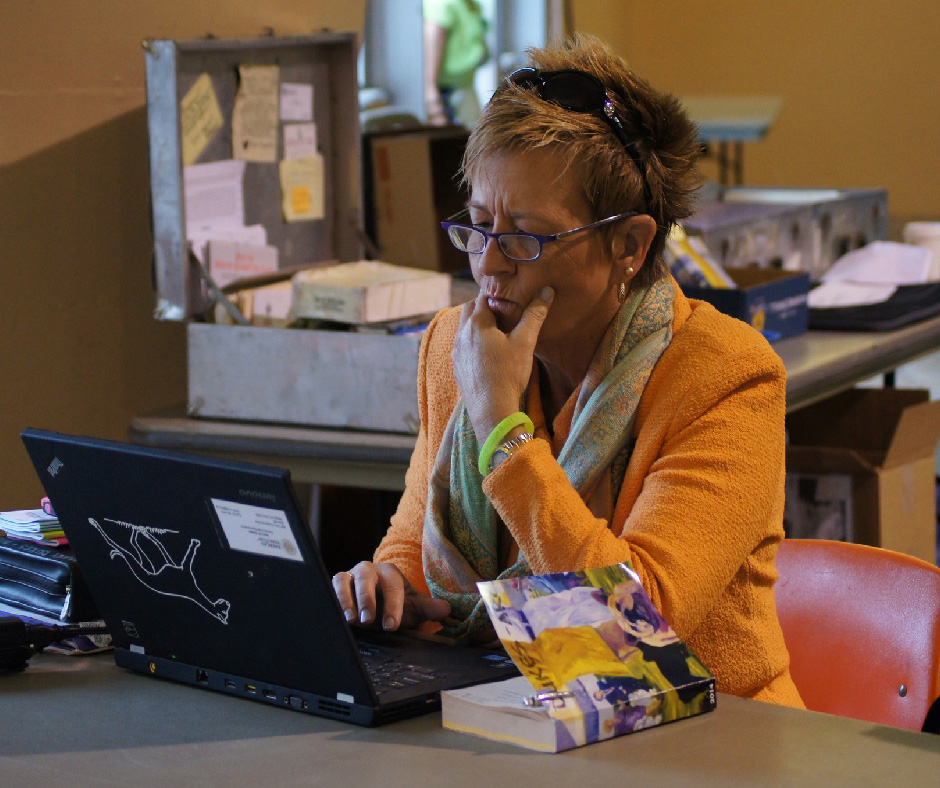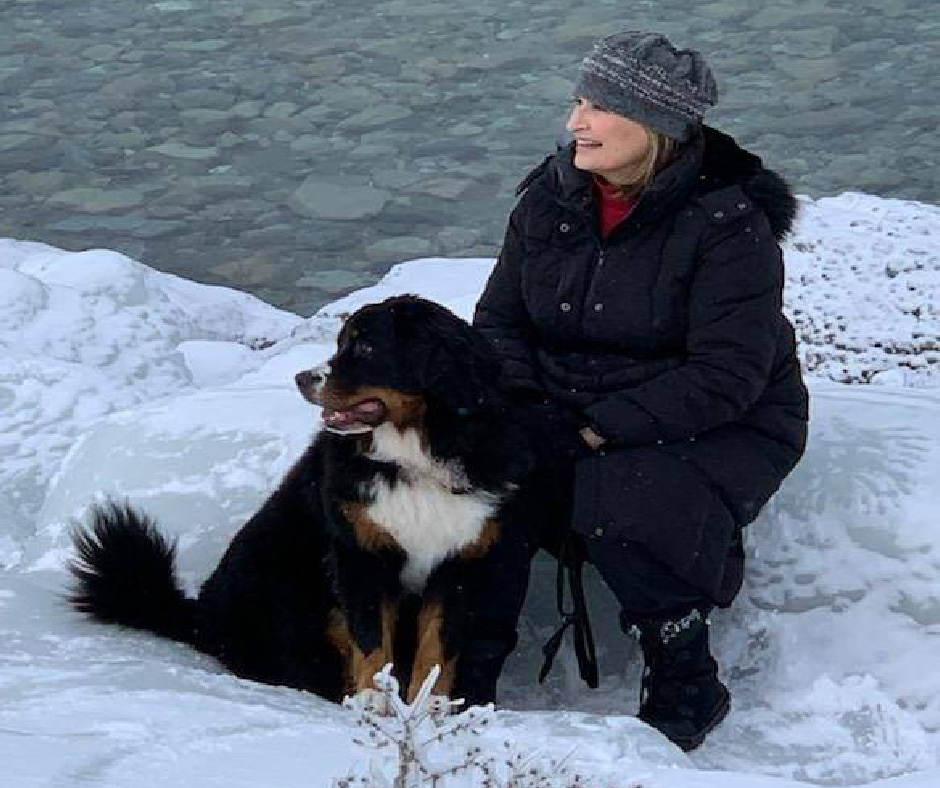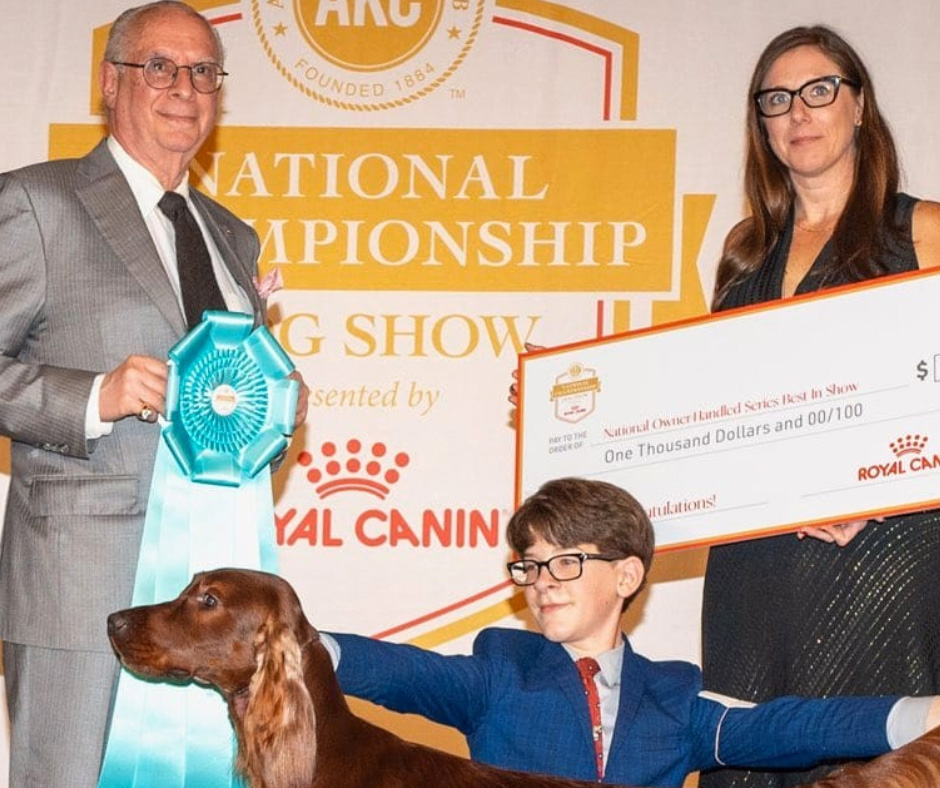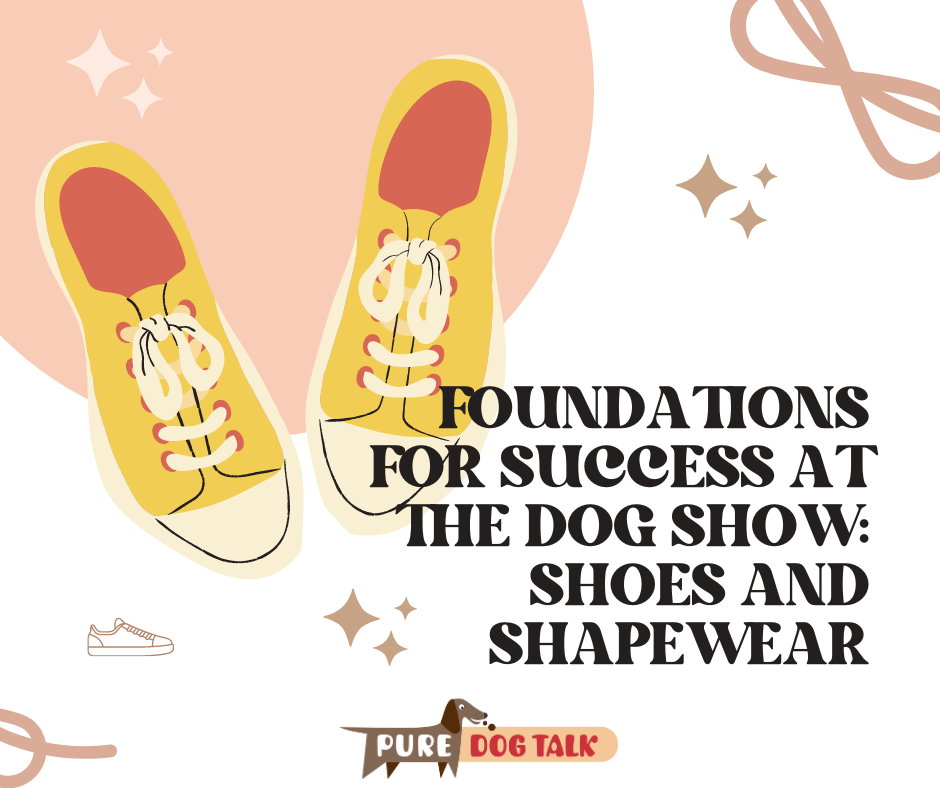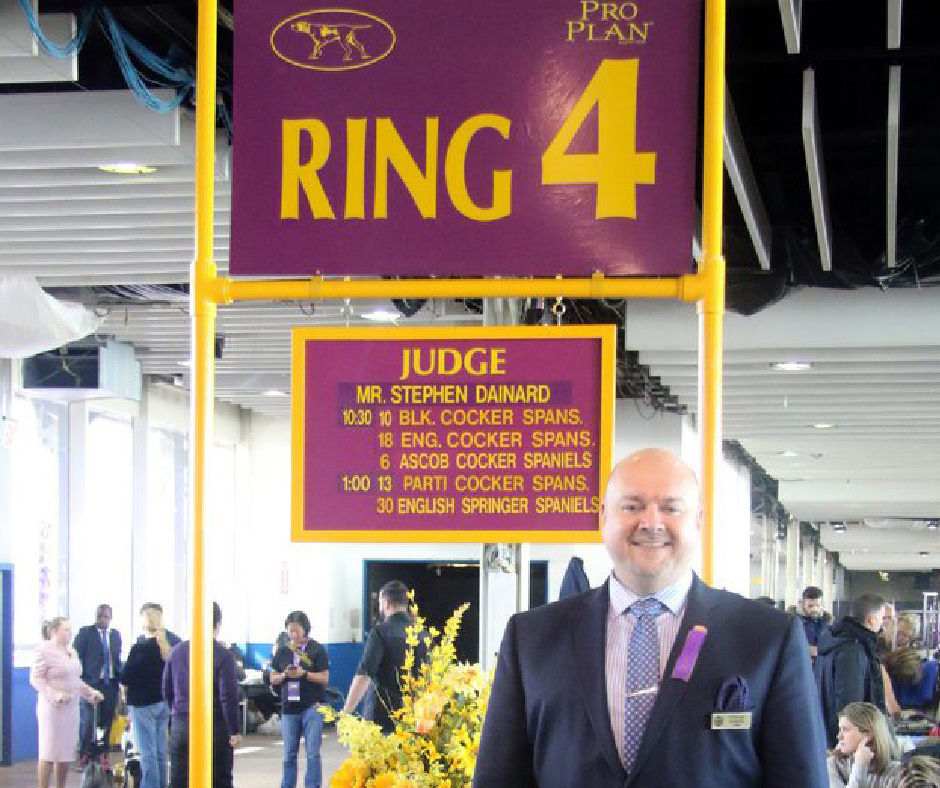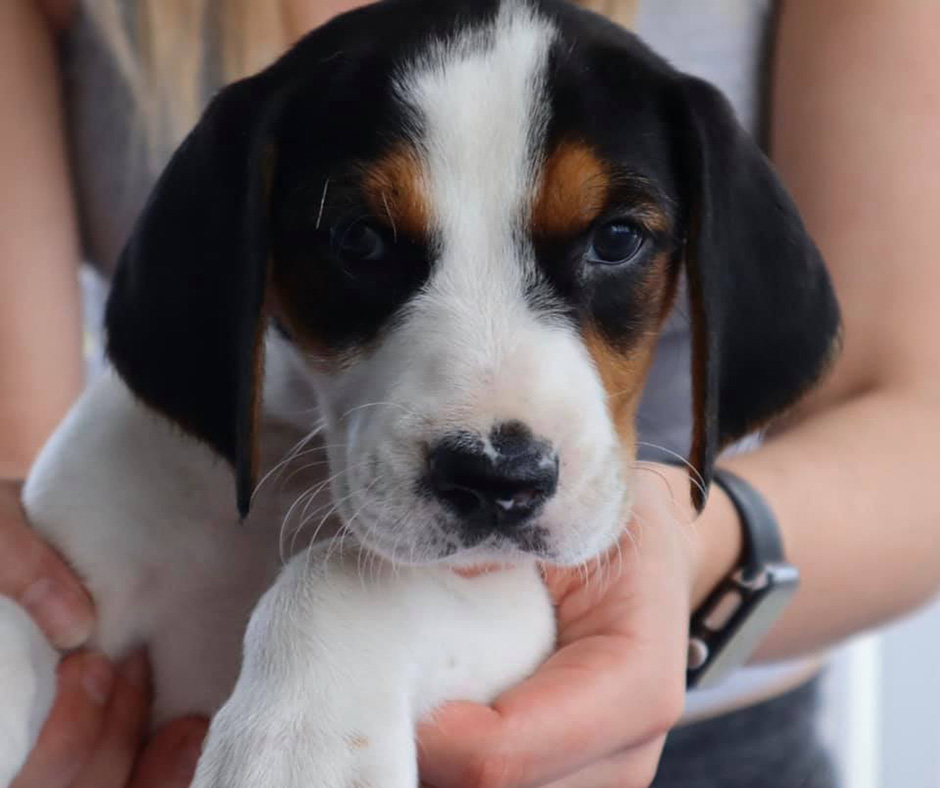616 – Mary Dukes: An Evolution from Owner to Professional to Rep to Judge
Mary Dukes: An Evolution from Owner to Professional to Rep to Judge
Host Laura Reeves is joined by Mary Dukes, legendary Whippet breeder, professional handler, AKC Executive Field Representative and now judge.

A 1991 advertisement for Dukes’ handling services.
Dukes has spent a lifetime involved in working with animals. From showing horses to training elephants to showing dogs. Her work with the zoo animals instilled in her an absolute dedication to animal husbandry.
NO Dirty Dogs
“There are no shortcuts in animal care. Period,” Dukes said. “In zoo animals, you have to be even more on top of it because wild animals don’t have a tell that they’re sick. In the wild, any tell that they are sick or injured is going to make them dead. So they are really good at masking that. If you are sloppy or dirty or messy there is no room for you in the animal business.
“I’ll put this on blast right now, if someone walks into my ring with a dirty dog, we’re going to have a problem. There is no excuse to show a dirty dog. I won’t hold it against the dog, but the handler might get an earful.”
AKC Registered Handler Program
Dukes was an early member of the AKC Registered Handler Program. As a rep, Dukes was a coordinator of the RHP. She joined RHP because they demanded insurance, inspections, so “I wanted to put my money where my mouth was.”
RHP is not a guarantee the handler is going to win with your dog, Dukes said.
“The whole point of the program is so the people have a place to start looking where we had done some of the ground work for you. You know they (they handlers) are insured. You know their vehicle is inspected for safety and cleanliness. You know their kennel has been inspected by AKC kennel inspectors. You know they’ve signed a code of ethics.
“RHP members have to have a contract. They have to bill in a timely fashion. The bill has to be itemized. A lot of the trouble you see, most of it is because the expectations weren’t clear. If you have a contract, it’s
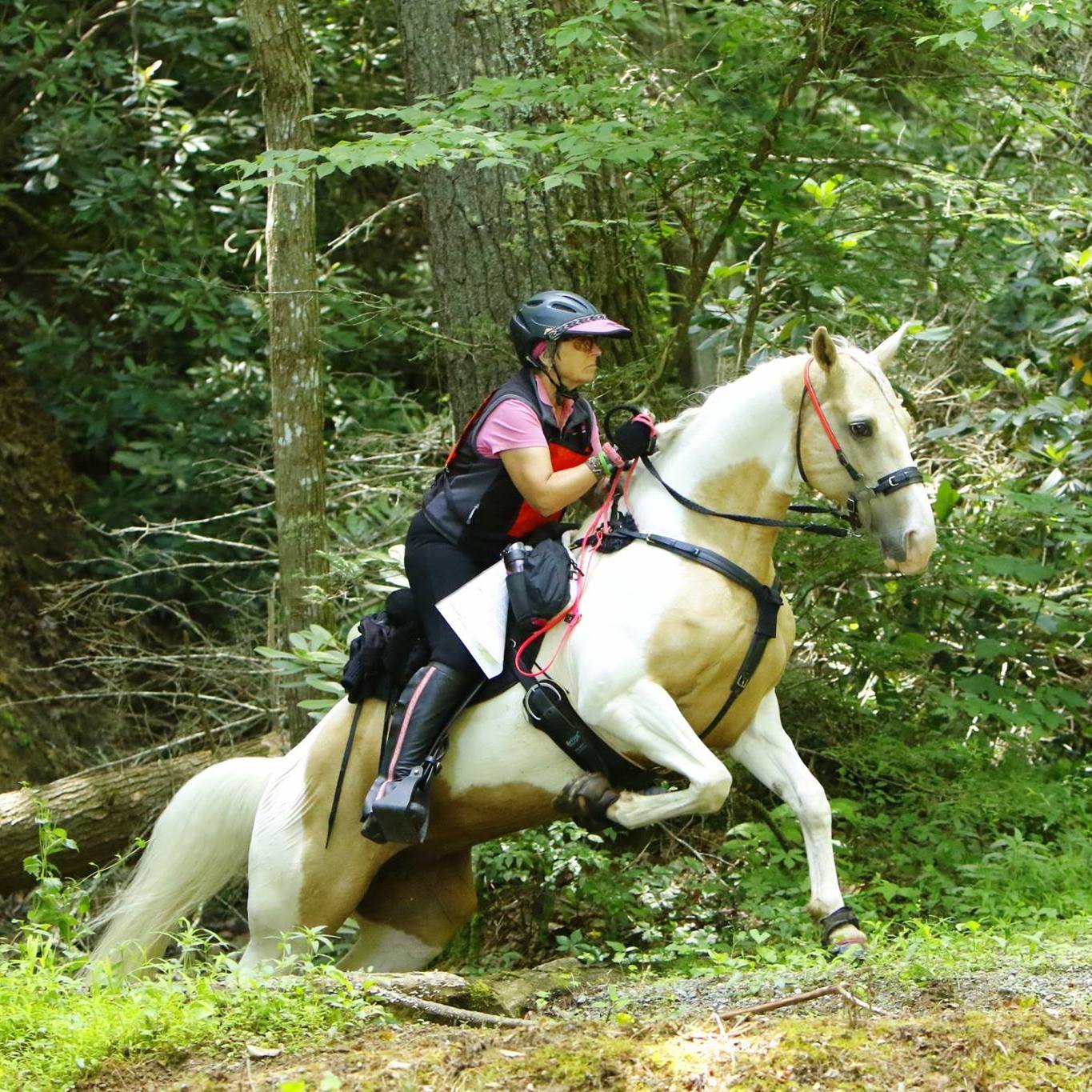
Dukes is still actively involved with horses. Her vacations frequently involve riding in exotic locales.
right there in black and white.
Safe Sport
“One of the newest requirements is SafeSport. All RHP members have to take the training as a condition of membership.
“Safe Sport is a congressionally mandated program for every Olympic sport.
“There’s been a lot of abuses in every sport. Basically, Safe Sport is making you aware of what to look for. If you see a situation that you suspect might be something, it gives you tools. Because we aren’t an Olympic sport, we don’t have access to the mechanics of the national organization.
“It automatically makes everyone (who’s had the training) mandatory reporters. If you put it out in the open more, it’s harder for someone to creep around. I would like to see it spread out to judges, especially juniors judges.”
Join us next week for part two of this fantastic conversation. Learn what Dukes is looking for in a dog and hear about her fantasy Best in Show lineup.
615 – BernerGarde Leads the Way in Open Sharing of Health Information
BernerGarde Leads the Way in Open Sharing of Health Information
Host Laura Reeves is joined by Lori Jodar, president of the BernerGarde Foundation, to discuss this legendary program.
BernerGarde has been collecting health and pedigree data on the Bernese Mountain Dog for nearly 30 years. The founder of this concept began in the 1960s gathering information on 3×5 cards. The non-profit foundation was created in the 1980s and now includes 215,000 dogs’ information.
“The mission of BernerGarde has always been genetic, genetic, genetic,” Jodar said. “And because of that, we’ve been able to stay on course. The Parent Club, the Bernese Mountain Dog Club of America, and the BernerGarde Foundation have remained very good partners throughout the years. So that’s a good thing.
“The most expensive thing that we have done to date is to start a repository. We started a DNA and tissue repository.
“We knew we wanted to study this malignant histiocytosis. So in 2006, we partnered with Michigan State University, Dr. Vilma, we call her Dr. Vilma. And she’s a brilliant researcher, as well as being a professor at Michigan State University Veterinary School, and she has managed a repository for us. We have 4,000 unique dogs in the repository, and I don’t know how many tumors we have, but not that many, but like 1,000, we use for research.
“It’s very expensive, very, very expensive, but what has morphed out of that is there’s a group in France that has been studying histiocytic sarcoma for a long time, and they are finding some answers. So, we have shared DNA with them, tumor submissions with them. We’re about to send several hundred DNA samples to them for their continuing research.
“The database that we have is so vibrant and vital to the community. I don’t think I can overstate it. It’s become part of everybody’s life. And if they complain about anything, they… they being the community of breeders, they complain about anything, it’s that there’s never enough information.
“Through this database, there’s health records. We divide the health records into what we call anecdotal and diagnosed. So, to be diagnosed, you have to have veterinary support, a pathology report or veterinary report to actually have a diagnosed condition. And then we do all the health certs, you know, we get a quarterly thing from OFA on hips and elbows and whatever they’re doing.
“We also have, you know, about 50% of the dogs in the database now are not US, they’re from Europe and Australia and Canada. So, we needed to learn how to interpret all of those records like through the FCI in Europe. And oh it’s a lot. So, we have database operators all over the world now. We have about 30 of them and they’re kind of the in-between, between the people that want to submit information.
“We are so focused on accuracy that I think that has given us legitimacy, actually, that focus.
“If you got a bitch and you are looking for a stud, you can go to our database. We have a stud-finder and you can put in parameters. What the age is, do they need their hips, do they need their elbows, do they need DM, do they need whatever it is that you feel you need for your breeding. And then, we’ll just… spit out a list of stud dogs.
“You can also do trial pedigrees. We also do COIs, Coefficient of Inbreeding, for every dog. You can put five pictures of your dog in there.”
614 – Neonates: Hypoxia, Hypothermia, Hydration, Hypoglycemia
614 – Neonates: Hypoxia, Hypothermia, Hydration, Hypoglycemia
Dr. Marty Greer DVM joins host Laura Reeves to talk about the four H’s that constitute critical care of neonates: Hypoxia, Hypothermia, Hydration, Hypoglycemia.
“The four H’s are hypoxia which is oxygen,” Greer said. “Hypothermia which is temperature, hypoglycemia which is glucose and hydration which of course is hydration or dehydration. So we’ve got those four parameters and basing the rest of the discussion on that, we can get started with some pretty important things that you can do at home to measure, to manage. It doesn’t do you any good if you can’t manage it. But collecting the data doesn’t do you any good unless you use the data.
Greer notes there is currently no good way to measure blood oxygen levels in puppies at home, but that physical indications will give you an accurate starting place.
“You can look at puppies and say, are they nice and pink,” Greer notes. “Do they have a curled pink tongue? Or is their tongue kind of grayish, blueish, a little bit flat? So curled pink tongue means you keep working even at one minute, five minutes of age, curled pink tongue with that curl to the edges, you keep going. If it’s gray and flaccid and you’ve got other puppies that need your help, set that one off to the side, keep moving.”
Greer recommends breeders consider investing in an incubator and oxygen concentrator. She advocates for the Puppy Warmer system in particular.
Well-hydrated puppies will have very pale yellow urine when stimulated with a clean cotton ball or tissue, Greer observes.
“For me, hypoxia is first,” Greer said. “For me temperature is second and then hydration is third. That’s my particular order. Hydration is very important but temperature in the immediate birth period, in that first hour after birth. Puppies come out wet… They come out without any oxygen in them, other than what they got from their mom. So, they’ve got to start breathing immediately, and they’ve got to stay warm.
“And so you want to get them born into enough absorbent material, like warm towels, that you can very quickly get the puppies dried off. Again, the incubator that Puppy Warmer has is a great place to put them for drying.
“I like heat sources under the puppies, under the bitch and under the puppies. I don’t like the ones that come from above. The ones from above, I have concerns about dehydrating the puppies. I have concerns about the bitch getting too warm and not wanting to stay with her puppies. I’m concerned (about fires) started with heat lamps. So, I’m really not a fan of the overhead heating.
This is the first in a planned series of episodes about neonates, their care and deep dives into the first hours of a newborn puppy’s life. Listen in for more today and BOLO the first Monday of every month for more from Dr. Greer.
613 – Junior Handler Wins NOHS Finals in Orlando
Junior Handler Wins NOHS Finals in Orlando
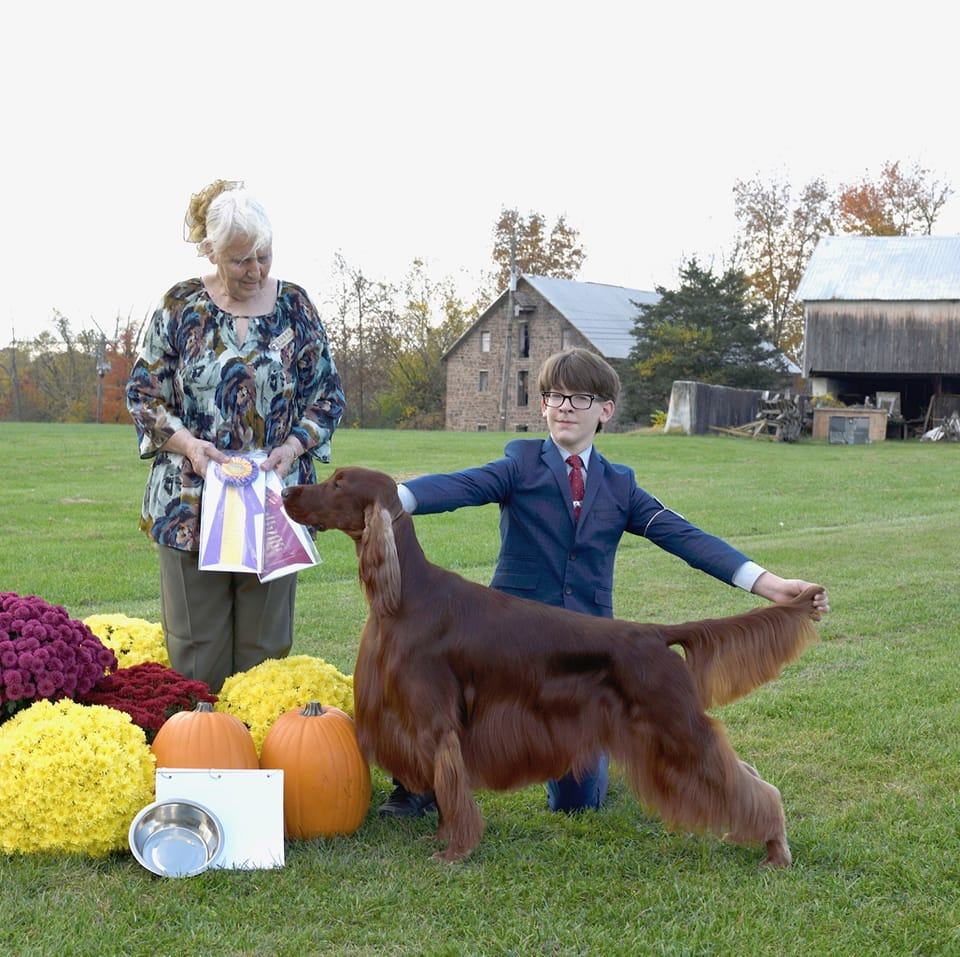
Adam showing his dog to Best of Breed.
The 2023 AKC National Owner Handled Series Finals was won by 14-year-old Adam Kucera and his two year old Irish Setter, Stryker. Adam and Stryker’s breeder, Patty Fanelli, join host Laura Reeves to share their story.
“At (Adam’s) first show, he beat me for Winner’s Dog,” Fanelli said. “It was one point with the brother. The next show was the Potomac Specialty. He went best in sweeps and he took a five point major and went best of Winners and best puppy.
“And I said to him, “You just took a five-point specialty major.” And he said, ‘I don’t even know what that is.’ He sure knows now.”
Stryker is Adam’s first Irish Setter that his grandmother arranged to purchase from Fanelli. He showed a Boston Terrier first, but really wanted to show a bigger dog.
Adam says he does all of Stryker’s grooming “except the clipper work because I am so afraid he’s going to just move and it’s just going to go, it’s all gone.”
The most challenging part of training Stryker, Adam said, was teaching him to freestack “Because he always just wants to jump, he always just wants to jump on my shoulders and thinks it’s time to play as soon as I hold a treat and not hold him.” A 4.0 home-schooled student, Adam says he practices with Stryker every morning before completing his school work.
Competing in NOHS gives Adam and is family more time to spend at the shows.
“My first show, we went to the show and I didn’t win the breed,” Adam said. “We went to go watch the groups and we saw that there were two groups going and we were like ‘why are there two, there should only be one?’ So then we found out what owner handler was. It’s kind of hard to show an Irish Setter. There’s not that many owner handlers out where I live, so if we want to stay a little bit longer at the show, we can do owner-handled and that gives us stuff to do and it’s a really fun competition.”
Adam has set lofty goals for himself and his dog. His remaining goals for Stryker include winning best of breed at the National Specialty and winning the breed at Westminster Kennel Club. He dreams of becoming a professional handler and breeding Irish Setters in his future.
Take a listen to the entire episode for more from this outstanding young man.
612 – Clubistry: Websites Designed for Dog Clubs
Clubistry: Websites Designed for Dog Clubs
Host Laura Reeves is joined by Jennifer Johnson and Brent Wiethoff from Dialogs who have created and are building a service called Clubistry. The service designs websites specifically for dog clubs.
“Younger generations are not as keen to join clubs,” Johnson said. “They don’t always really know that there are parent clubs or that there might be a value to, or something that they can gain from joining their national parent club. And part of fighting that is to have an online presence and online applications.
“We see a lot of people who don’t want to download a PDF. If I have to mail something, I have to go find a stamp. I have to find an envelope. I don’t know where they are. I don’t use them very often anymore on purpose. Moving applications to an online form helps increase the number of applicants you get because you can fill it out all in one step and submit it at it’s done as opposed to, ‘that looks like something I want to do, but I’ve had to download this and now I have to cook dinner. So I’m just gonna set this aside’. And then they never get back to doing that thing.
“A Facebook presence or other online platforms becomes more important these days because this is where people go to find out about information and there’s a lot of bad information on social media. So it’s… really important for clubs to have an official presence on social media. So they have a voice. They have an official representation and an official voice. You can’t really ever stop the bad voices, but if you are not one of the voices, then all they hear is the bad stuff.
“Anybody can spin up a WordPress website and you buy a template and then you start dropping your own content into it and it breaks. The design breaks. It looks bad. It doesn’t look good on mobile. The person who had the login information leaves the club or your volunteer moves on to other things. Or you’ve hired somebody off of Craigslist or Facebook Marketplace to do the work for you. And now they’ve gone on to college or a girlfriend or a different life and are no longer available.
“Domain names, you register your domain name, somebody in your club registers your domain name. And then it was 30 years ago and nobody knows who it was that did it. I have seen clubs lose their domain entirely because they don’t know who has the login information for it, and then it gets purchased by somebody else to be held for ransom for a large amount of money.
“Same with the websites, somebody built it, nobody knows who or nobody has the login information anymore. Volunteers die or move on to other things. All these things happen. We’ve heard all these stories. We’ve got our roster in an Excel sheet, and you have one person who’s in charge of the roster, but they have another person that’s helping them with it. Now you have two copies of the roster.”
For more on this great service, listen in to the entire episode!
611 – Foundations for Success at the Dog Show: Shoes and Shapewear
Foundations for Success at the Dog Show: Shoes and Shapewear
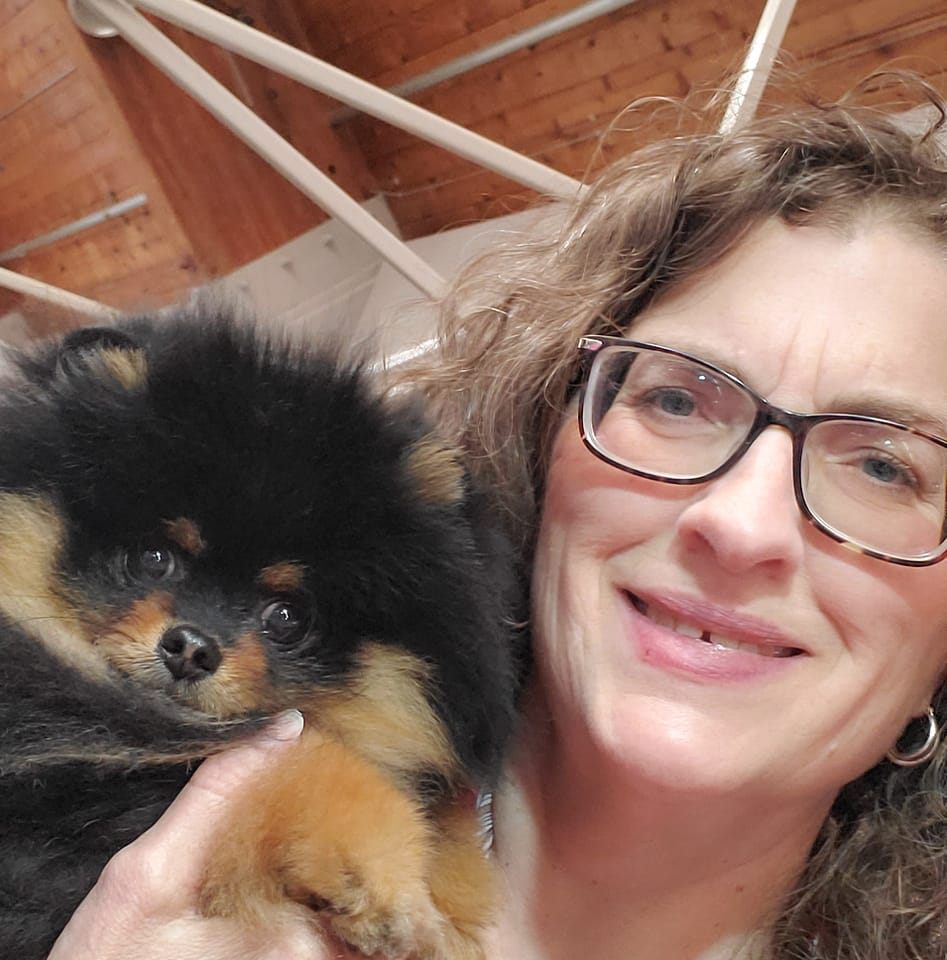
Veronica Wolfe, owner at Best in Show Clothes
Veronica Wolfe, owner of Best in Show Clothes, joins host Laura Reeves with professional advice on shoes, shapewear and other foundations for success at the dog show.
“I’ve become passionate about good shoes,” Wofe said. “And I’ve been known, a couple handlers can attest to this, of grabbing people and going, you need to get out of those shoes because you will have hip and knee and back problems before you’re 35 if you don’t. So, yeah, it’s important.
“If you can find a small shoe store in your area that actually has a fit specialist … I would be go to one. I would run to one. But you also need to know a little bit about your own foot issues. Do you roll in? That’s called pronating. Do you roll out? There are different things. Do you have high arches? Low arches? There are running stores now that you can go in and put your feet on things and it will show you your arch. There’s a couple things that you want.
“You do want some cushioning. We’re in concrete all day. I’m not running circles, but I’m standing in a booth. You know, we’re in concrete all day. People are running all day. You need something with some good cushion.
“You want to look for a non -slip sole. Some of the stores online now actually actually say non -slip. If you need an arch, you need a good arch. Arch supports. You can get them for $40, $50 at running stores. I’ve seen them in sections sometimes at like TJ Maxx and Ross. And the over -the -counter ones, I’ve been told by a shoe specialist, are as good as the custom $400 podiatrist ones.
“It almost seems like there’s more options for guys and you’ve got this balance, right? So you can get a nice leather shoe for an indoor show, but you’re going to ruin that leather shoe at eight a.m. in the morning when there’s dew outside. So, you’ve got some nicer looking skater shoes, but the problem with those is there’s generally very little arch support.
“I have a number of (women) clients who do not like the way their calves look, and they’ll be in boots even in the summertime. I think they look quite attractive if you’re wearing a skirt and a blazer or maybe if you want a denim skirt. I would just say try and keep a nice line between them so you have a skirt then you’ve got a gap and you’ve got your skirt. Maybe black hose or tights that make that transition seamless, so it’s not like this distracting line there. But you’ve got some really comfortable boots out there that will have that arch support or it’s easy to insert one in it.
Pro tip from Laura:
Pro tip from a handler perspective: have more than one pair of shoe for each day.
Change shoes, because even if it’s just changing the angle of your heel this much, it makes an enormous difference. Pat Rogers is the one who taught me that a million years ago as a handler, change your shoes at lunch, and it makes all the difference in the world.
Pro tip from Veronica:
don’t let your shoes get run down. If you are an exhibitor that’s going out every weekend, six months max, you need to toss those shoes.
For more on the essentials of foundations under our clothing, listen in to the full episode.
610 – Canine Influenza Outbreak and How to Manage It with Dr. Marty Greer
Canine Influenza Outbreak and How to Manage It with Dr. Marty Greer
Dr. Marty Greer, DVM joins host Laura Reeves to discuss the current Canine Influenza outbreak, how to manage it and how it became an overnight sensation in the public.
“Well, partially it’s media, partially it’s misinformation, courtesy of the media,” Greer said. “And partially there was a lack of vaccine. The vaccine insufficient supply appears to have been corrected or is being corrected.
“So, things are better. In 2004 when this first happened, we didn’t have any vaccine and no dogs in any part of the world that we know had immunity to this. So Ron Schultz,the vaccine guru from University of Wisconsin, made a recommendation that all dogs should be vaccinated against this, that it should be considered a core vaccine because no dogs had natural immunity.
“It was like when Parvo happened in the late 70s and early 80s came out of nowhere, there was no immunity and bada bing bada boom we’ve got dogs that are desperately sick and dying.
“Influenza is a respiratory disease and it is classified in the CIRD, the canine infectious respiratory disease complex. So a lot of times that’s either called CIRD or it’s called kennel cough. There’s a whole bucket of stuff that falls in the kennel cough bucket and it’s not necessarily a diagnosis. It’s a description. It’s a collection of disorders, diseases, but it’s not necessarily a diagnosis.
“So we have had outbreaks of canine influenza (before). The first known outbreak was in 2004 in a colony of Greyhounds, I believe in Florida, and they think it was a mutation from the equine version of influenza.
“And that was H3N8. There’s now also an H3N2 that we have identified and can vaccinate against.
“Like all respiratory diseases, it causes a cough, but in this particular case, influenza can cause disease severe enough to cause hemorrhagic pneumonia and the death of patients. And there have been patients that have died in this last outbreak that occurred this fall (at the Golden Retriever national in Albany, Oregon).
“It had to get to the Golden Retriever National somehow. It’s not like the Golden Retriever group invented it, just drummed up a new virus, but it appears that it reared its ugly head there. There were a number of dogs that were there that then went back to all over the U.S.
“So, they were East Coast, Midwest, everywhere. And these dogs were coming back with respiratory disease and it was easy to just say, ‘Uh, it’s kennel cough, here’s some medication, you’ll be fine.’ But one of my associates was involved with some of the Golden Retrievers that were at that show and I was in surgery the day she walked in and said, ‘You know, we’ve got these dogs that are coming back from the Golden National with a pretty bad cough.’ And I don’t know why but the hair kind of stood up on the back of my neck and I said, ‘We need to get these dogs tested for what kind of virus or bacteria we have.’
“There was just something about, I don’t know if it was her tone of voice or the number of dogs that were involved. There’s something about that conversation that just said to me, ‘We have problems.’
“So, we swabbed the most recently started to cough dogs. We didn’t want a dog that had already been coughing for a week by the time we did the sample collection and submitted that to our local diagnostic lab at the same time that a number of other people were submitting samples.
“We weren’t the only ones by any stretch of the imagination that felt we need a diagnosis on this. So, at our diagnostic lab in Wisconsin, they came back with influenza A. At some of the other diagnostic labs, they came back with influenza H3N2, I believe. Not that it makes that much of a difference if it’s H3N2 or H3N8. It’s influenza anyway. So, there were multiple labs with multiple dogs that had all been at the same event.
“They were coming up with the same answer. And so, when I walked up to my front desk last week and on the computer screen in front of my receptionist, there was a message from the media that said, “Mystery disease.” I was like, ‘It’s really not this mysterious, folks.’
“And so, we need to start addressing it by getting more dogs vaccinated. So, it’s time for us to not call it a mystery disease. It’s time for us to make some decisions on whether this is a lifestyle vaccine or a core vaccine and get some of these dogs vaccinated that are at risk because this is a very serious illness.
“No question that if the dogs don’t have immunity, it’s a very serious illness. Like I said, it causes hemorrhagic pneumonia. Some of these dogs are dying. Even if they’ve been put on ventilators and all the really high-powered stuff that they’ve been doing, sometimes we’re still losing dogs to this. And it’s really a shame to lose dogs to a disease that we can vaccinate against.
“I don’t care if you’re doing agility or fly ball or competition with hunt test or field trials or confirmation. If you’re going to the dog park, if your dogs are going to the groomer, any dog that qualifies as based on lifestyle for bordatella vaccinations should also be receiving influenza vaccine.”
609 – Critiques, Communication and Common Sense in Dog Shows
Critiques, Communication and Common Sense in Dog Shows

Steve Dainard judging Spinoni back in the day, when Laura was still showing dogs.
Canadian Kennel Club judge Steve Dainard is back with host Laura Reeves for part two of a probing and thoughtful conversation about critiques, communication and common sense in dog shows.
“So we know that every rule and regulation that came in probably had a foundation in someone doing something wrong,” Dainard notes. “Judges need to keep their interactions in the ring, not be too conversational in nature. Well, then all of a sudden you’re going to get a whole population of judges who take us to the nth degree, and they’re even afraid to have any type of communication, apart from instructions to the exhibitor.
“So, I think there’s a fine line between having this full on getting caught up in the ring, but also having, an opportunity to be able to share meaningful dialogue. And I think that we can do that. I think that maybe we’re just not trained really well to do that. So maybe we need to have a discussion about what does that look like.
“I get it, writing written critiques or an oral critique or whatever can be scary for many people. People don’t like change, and whether it’s not because you don’t have the goods or you don’t know whatever, maybe that’s what the fear is based in. But I think culturally, you just hit the nail on the head, it’s not encouraged to have that dialogue, that communication, that interaction. And what it does, it creates silos within our sport. And this is not what we need. We need to be able to have a mechanism in place so that it’s okay to have a conversation.
“And that conversation doesn’t need to be precipitated by the fact that I’m pissed off because Laura didn’t put me up and I’m going to take a run at her after judging. And I got the rep coming with me because she crossed a line.
“Having a written critique foundation in your toolkit as the basis for how you’re trained to evaluate dogs creates a much easier conversation when that’s the way you’re programmed and how you’re picking your winners.
“I think that the fear of error is like, (exhibitors are) judging me, right? So I can see why people would be afraid of that until you get really good at it. And you have the conviction to be able to say, this is my process. I think it could be a little bit of an overwhelming concept, but the only way we rip that bandaid off is by diving in and starting to practice it.”
Listen to the full episode for insights on the role of judges in promoting responsible dog breeding and ownership and much more.
608 – Dog Judging Process and Ethics with CKC Judge Steve Dainard
Dog Judging Process and Ethics with CKC Judge Steve Dainard
Host Laura Reeves is joined by Canadian Kennel Club all-breeds judge Steve Dainard for part one of their conversation about the judging approval process, judging ethics and other hot button topics as we progress through “meat and potatoes” November!
“So how do we help judges move into a place of thinking more about structure and less about the ‘paint job’,” Laura asks.
“Some of the biggest challenge is, do (judges) have that breed specific knowledge,” Dainard replies. “And are we consistent in this application? Are we judging fairly and equitably and being consistent enough so that people that are watching, and in particular breeders, can follow and they can say, this person really knows my breed?
“CKC judges get scrutiny from other non-Canadian judges about how we get there too quickly. and that maybe you know in your country, it takes it takes longer to get there. So, let’s agree that maybe somewhere in the middle might be more ideal.
“Organizing bodies do the best they can, given the current environment, to come up with a fair and equitable process. They don’t always get it right and many times changes just are just so laborious, it takes so long and really, what is the right fit. So, I understand those challenges.
“So, I think we need to work within the constraints of what we’re handed with hopefully trying to make improvements along the way. Some of those challenges are making sure we have breed specific knowledge, that we’re not missing the hallmark characteristics of a breed and just going for a more of a generic exhibit.
“If you have to ask, ‘Is there a Rule against that’, what’s happening is your moral guideline. Your compass is probably kicking in. I think you’ve already answered your question. If you have to question yourself like that, whether there’s a rule or regulation specifically forbidding that is irrelevant. You’ve already answered your question. It should not happen.
“We were raised in the sport. We spent decades in the sport. We know a lot of people. So now because we’ve chosen to change hats to now become judges, all of those relationships and those hotels we shared and vehicles we traveled in those don’t go away.
“My interpretation is that when that’s said as the reason to justify a win, my gut goes to ‘Have you really evaluated everything. Did you fairly look at the dogs in competition.’ Many times, I don’t think you’re really did that. I think that the political excuse was the easy excuse for you to justify that in your mind and poo poo the credibility of the ethical issue around the judging process.”
607 – Keeping Foxhounds Alive Into the 21st Century
Keeping Foxhounds Alive Into the 21st Century
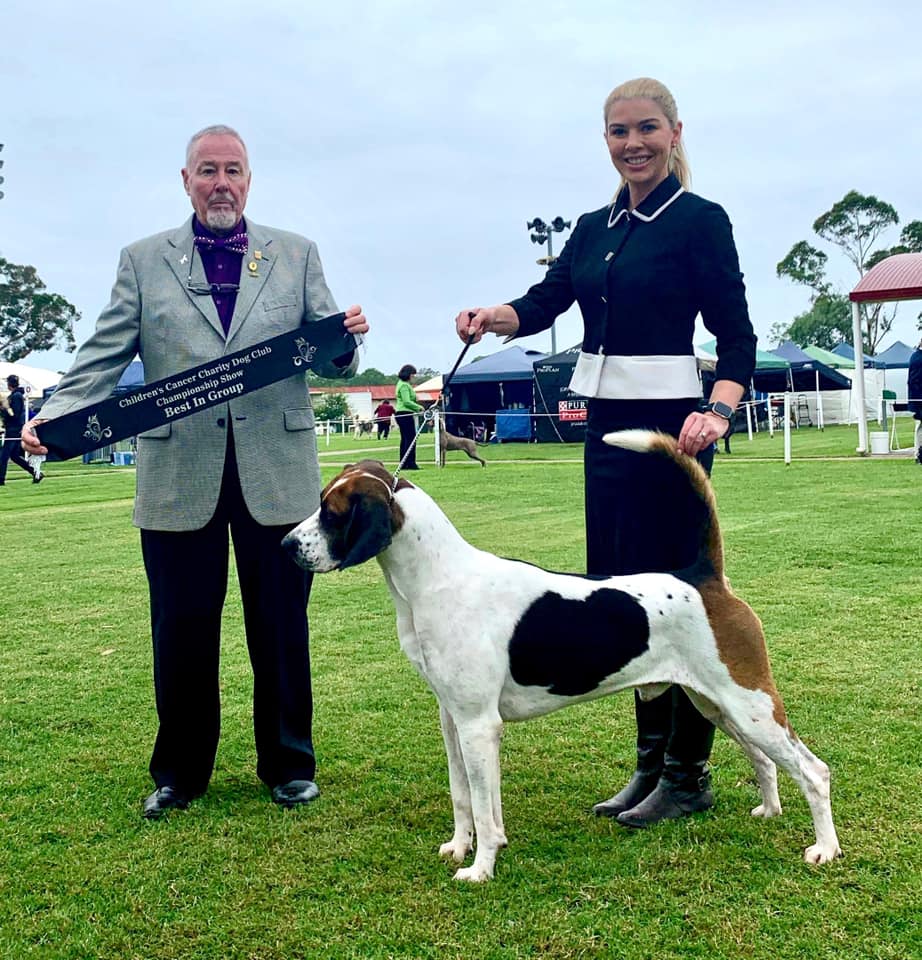
Brigette Bryson with one of her Foxhounds.
Brigette Bryson, second generation breeder of Foxhounds at Foxhunt Kennels in Australia, joins host Laura Reeves in a wide ranging conversation about English Foxhounds, preserving the history they represent and how she hopes to keep the breed alive into the 21st century.
There are three breeders of English Foxhounds listed on the US National Club website. In 2022, the breed dropped to last place in numbers of dogs registered with AKC. Although the breed lives on in the packs around the globe, their popularity has certainly faded from their heyday when hunting fox was both useful and fashionable in much of the world.
“I don’t know if that’s ever going to change dramatically,” Bryson said. “I have this conversation with people regularly. I don’t know that you can ever make them mainstream. Their history is so deep. And it’s entrenched in people’s brains that this is a hunting and a working breed that’s not gonna fit in my suburban backyard.
“So I don’t know if you can ever change that. My goal is just to see them survive. That will happen in the packs. There’s many packs. You know, we’re not gonna have a figure of how many dogs exist in those packs, but they’re there. And I think that they will always be there through people like me that have maybe grown up in that pack and they’re obsessed with the breed, so they’ll keep it going.
“What I would like to see is if we could have a few breeders in each country breeding them, that would be a success for me. It’s enough to keep them alive and not let that piece of history die for me. I think I really enjoy the history of the breed. I love that almost every kennel club you visit around the world is gonna have a painting of Foxhounds hunting. I think it’s important to maintain it for that reason.
“I of course would love to see them become more popular with the general public. I just don’t know if that’s possible. The sizes of houses and properties and everything, it’s gonna be the same problem for all large breeds. It’s getting smaller.
“And realistically, as much as you can raise them to live in a smaller environment, it’s not ideal for them and people would have to put in a lot more effort to meeting their energy needs. My goal is just to get them out there with breeders around the world. That’s what I’m trying to achieve now.
“There’s not a single registered breeder that has had a litter in the UK that I can think of in the last 10 years. We have one active registered breeder in New Zealand who’s fantastic. And there’s a few really healthy packs over there that have some dogs from us as well.
“And in America, there’s a handful if they even keep breeding, but they start aging out too. And that’s what’s happening here. There was four main breeders that we had, myself and my parents before me worked in with. One of those hasn’t bred a litter for a decade. And the other two are at the point where they’re saying to me, I don’t know if I’ll have any more just because they’re getting a bit older.
“And (Foxhounds) are incredibly healthy. Now that’s another one that’s complex. Foxhounds have been largely inbred since the beginning of time. But with that, only the strong survived. There is no hereditary diseases in the breed.
“Part of that is that there hasn’t been human intervention. So, all the debates that people have about inbreeding, and I have this debate with people regularly, because they’ll say to me, you’re gonna have to outcross. And I say, well, you need to outcross because you’ve got problems you need to fix.
“But if I don’t have any problems, why do I need to do that? A litter we had last year was from a six -year -old maiden bitch, 15 puppies. So, we’re not having those issues that other people have. They’re incredibly healthy. And people buying these dogs that they spend thousands and thousands and thousands of dollars trying to keep alive, I can sell you a Foxhound that will only have to go to the vet for its vaccinations.”

